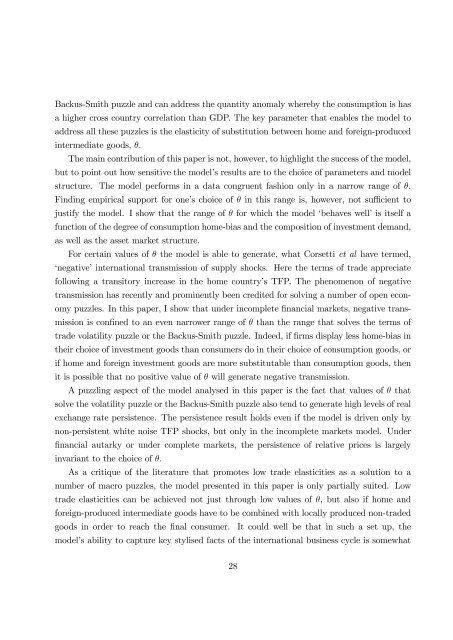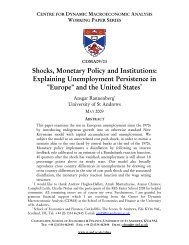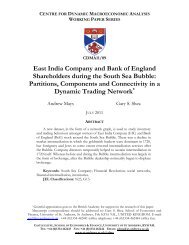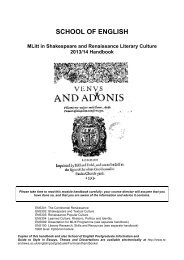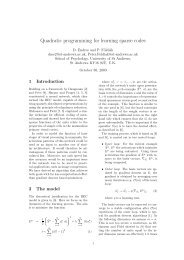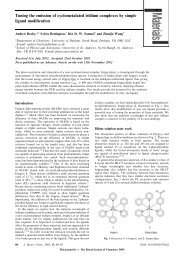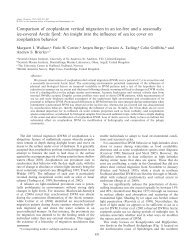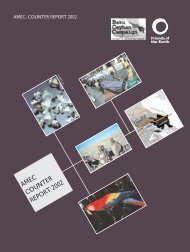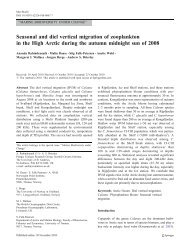Exchange rate dynamics, asset market structure and the role of the ...
Exchange rate dynamics, asset market structure and the role of the ...
Exchange rate dynamics, asset market structure and the role of the ...
Create successful ePaper yourself
Turn your PDF publications into a flip-book with our unique Google optimized e-Paper software.
Backus-Smith puzzle <strong>and</strong> can address <strong>the</strong> quantity anomaly whereby <strong>the</strong> consumption is has<br />
a higher cross country correlation than GDP. The key parameter that enables <strong>the</strong> model to<br />
address all <strong>the</strong>se puzzles is <strong>the</strong> elasticity <strong>of</strong> substitution between home <strong>and</strong> foreign-produced<br />
intermediate goods, .<br />
The main contribution <strong>of</strong> this paper is not, however, to highlight <strong>the</strong> success <strong>of</strong> <strong>the</strong> model,<br />
but to point out how sensitive <strong>the</strong> model’s results are to <strong>the</strong> choice <strong>of</strong> parameters <strong>and</strong> model<br />
<strong>structure</strong>. The model performs in a data congruent fashion only in a narrow range <strong>of</strong> .<br />
Finding empirical support for one’s choice <strong>of</strong> in this range is, however, not su¢ cient to<br />
justify <strong>the</strong> model. I show that <strong>the</strong> range <strong>of</strong> for which <strong>the</strong> model ‘behaves well’is itself a<br />
function <strong>of</strong> <strong>the</strong> degree <strong>of</strong> consumption home-bias <strong>and</strong> <strong>the</strong> composition <strong>of</strong> investment dem<strong>and</strong>,<br />
as well as <strong>the</strong> <strong>asset</strong> <strong>market</strong> <strong>structure</strong>.<br />
For certain values <strong>of</strong> <strong>the</strong> model is able to gene<strong>rate</strong>, what Corsetti et al have termed,<br />
‘negative’international transmission <strong>of</strong> supply shocks. Here <strong>the</strong> terms <strong>of</strong> trade appreciate<br />
following a transitory increase in <strong>the</strong> home country’s TFP. The phenomenon <strong>of</strong> negative<br />
transmission has recently <strong>and</strong> prominently been credited for solving a number <strong>of</strong> open economy<br />
puzzles. In this paper, I show that under incomplete …nancial <strong>market</strong>s, negative transmission<br />
is con…ned to an even narrower range <strong>of</strong> than <strong>the</strong> range that solves <strong>the</strong> terms <strong>of</strong><br />
trade volatility puzzle or <strong>the</strong> Backus-Smith puzzle. Indeed, if …rms display less home-bias in<br />
<strong>the</strong>ir choice <strong>of</strong> investment goods than consumers do in <strong>the</strong>ir choice <strong>of</strong> consumption goods, or<br />
if home <strong>and</strong> foreign investment goods are more substitutable than consumption goods, <strong>the</strong>n<br />
it is possible that no positive value <strong>of</strong> will gene<strong>rate</strong> negative transmission.<br />
A puzzling aspect <strong>of</strong> <strong>the</strong> model analysed in this paper is <strong>the</strong> fact that values <strong>of</strong> that<br />
solve <strong>the</strong> volatility puzzle or <strong>the</strong> Backus-Smith puzzle also tend to gene<strong>rate</strong> high levels <strong>of</strong> real<br />
exchange <strong>rate</strong> persistence. The persistence result holds even if <strong>the</strong> model is driven only by<br />
non-persistent white noise TFP shocks, but only in <strong>the</strong> incomplete <strong>market</strong>s model. Under<br />
…nancial autarky or under complete <strong>market</strong>s, <strong>the</strong> persistence <strong>of</strong> relative prices is largely<br />
invariant to <strong>the</strong> choice <strong>of</strong> :<br />
As a critique <strong>of</strong> <strong>the</strong> literature that promotes low trade elasticities as a solution to a<br />
number <strong>of</strong> macro puzzles, <strong>the</strong> model presented in this paper is only partially suited. Low<br />
trade elasticities can be achieved not just through low values <strong>of</strong> , but also if home <strong>and</strong><br />
foreign-produced intermediate goods have to be combined with locally produced non-traded<br />
goods in order to reach <strong>the</strong> …nal consumer. It could well be that in such a set up, <strong>the</strong><br />
model’s ability to capture key stylised facts <strong>of</strong> <strong>the</strong> international business cycle is somewhat<br />
28


